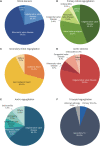Epidemiologic Profile of Patients With Valvular Heart Disease in Korea: A Nationwide Hospital-Based Registry Study
- PMID: 36693346
- PMCID: PMC9880350
- DOI: 10.4250/jcvi.2022.0076
Epidemiologic Profile of Patients With Valvular Heart Disease in Korea: A Nationwide Hospital-Based Registry Study
Abstract
Background: Valvular heart disease (VHD) is a common cause of cardiovascular morbidity and mortality worldwide; however, its epidemiological profile in Korea requires elucidation.
Methods: In this nationwide retrospective cohort study from the Korean valve survey, which collected clinical and echocardiographic data on VHD from 45 medical centers, we identified 4,089 patients with VHD between September and October 2019.
Results: The aortic valve was the most commonly affected valve (n = 1,956 [47.8%]), followed by the mitral valve (n = 1,598 [39.1%]) and tricuspid valve (n = 1,172 [28.6%]). There were 1,188 cases of aortic stenosis (AS) and 926 cases of aortic regurgitation. The most common etiology of AS was degenerative disease (78.9%). The proportion of AS increased with age and accounted for the largest proportion of VHD in patients aged 80-89 years. There were 1,384 cases of mitral regurgitation (MR) and 244 cases of mitral stenosis (MS). The most common etiologies for primary and secondary MR were degenerative disease (44.3%) and non-ischemic heart disease (63.0%), respectively, whereas rheumatic disease (74.6%) was the predominant cause of MS. There were 1,172 tricuspid regurgitation (TR) cases, of which 46.9% were isolated and 53.1% were associated with other valvular diseases, most commonly with MR. The most common type of TR was secondary (90.2%), while primary accounted for 6.1%.
Conclusions: This report demonstrates the current epidemiological status of VHD in Korea. The results of this study can be used as fundamental data for developing Korean guidelines for VHD.
Keywords: Epidemiology; Korea; Valvular heart diseases.
Copyright © 2023 Korean Society of Echocardiography.
Conflict of interest statement
The authors have no financial conflicts of interest.
Figures




Similar articles
-
Contemporary diagnosis and treatment of valvular heart disease in Korea: a nationwide hospital-based registry study.J Cardiovasc Imaging. 2024 Nov 22;32(1):37. doi: 10.1186/s44348-024-00036-z. J Cardiovasc Imaging. 2024. PMID: 39574207 Free PMC article.
-
Distribution, Characteristics, and Management of Older Patients With Valvular Heart Disease in China: China-DVD Study.JACC Asia. 2022 Apr 12;2(3):354-365. doi: 10.1016/j.jacasi.2021.11.013. eCollection 2022 Jun. JACC Asia. 2022. PMID: 36338396 Free PMC article.
-
[Clinical characteristics of patients with moderate or severe valvular heart disease].Zhonghua Xin Xue Guan Bing Za Zhi. 2024 Oct 24;52(10):1200-1206. doi: 10.3760/cma.j.cn112148-20230816-00082. Zhonghua Xin Xue Guan Bing Za Zhi. 2024. PMID: 39428370 Chinese.
-
Valvular heart disease: the influence of changing etiology on nosology.J Heart Valve Dis. 1994 Sep;3(5):516-26. J Heart Valve Dis. 1994. PMID: 8000586 Review.
-
Epidemiology of Valvular Heart Disease.Surg Clin North Am. 2022 Jun;102(3):517-528. doi: 10.1016/j.suc.2022.01.008. Surg Clin North Am. 2022. PMID: 35671771 Review.
Cited by
-
Contemporary diagnosis and treatment of valvular heart disease in Korea: a nationwide hospital-based registry study.J Cardiovasc Imaging. 2024 Nov 22;32(1):37. doi: 10.1186/s44348-024-00036-z. J Cardiovasc Imaging. 2024. PMID: 39574207 Free PMC article.
-
2023 Korean Society of Echocardiography position paper for diagnosis and management of valvular heart disease, part I: aortic valve disease.J Cardiovasc Imaging. 2024 Jul 26;32(1):11. doi: 10.1186/s44348-024-00019-0. J Cardiovasc Imaging. 2024. PMID: 39061115 Free PMC article. Review.
-
2023 Korean Society of Echocardiography position paper for the diagnosis and management of valvular heart disease, part II: mitral and tricuspid valve disease.J Cardiovasc Imaging. 2024 Jun 25;32(1):10. doi: 10.1186/s44348-024-00021-6. J Cardiovasc Imaging. 2024. PMID: 38951920 Free PMC article. Review.
-
Validation of TRI-SCORE for Outcome Prediction After Isolated Tricuspid Valve Surgery in Asian Patients.J Am Heart Assoc. 2024 Apr 16;13(8):e032929. doi: 10.1161/JAHA.123.032929. Epub 2024 Apr 2. J Am Heart Assoc. 2024. PMID: 38563385 Free PMC article.
-
Current Status of Tricuspid Valve Interventions in Asia Pacific Region.JACC Asia. 2025 Mar;5(3 Pt 2):405-423. doi: 10.1016/j.jacasi.2024.10.008. Epub 2024 Dec 17. JACC Asia. 2025. PMID: 40148013 Free PMC article. Review.
References
-
- Coffey S, Roberts-Thomson R, Brown A, et al. Global epidemiology of valvular heart disease. Nat Rev Cardiol. 2021;18:853–864. - PubMed
-
- Yadgir S, Johnson CO, Aboyans V, et al. Global, regional, and national burden of calcific aortic valve and degenerative mitral valve diseases, 1990-2017. Circulation. 2020;141:1670–1680. - PubMed
-
- Binder RK, Dweck M, Prendergast B. The year in cardiology: valvular heart disease. Eur Heart J. 2020;41:912–920. - PubMed
LinkOut - more resources
Full Text Sources
Research Materials

